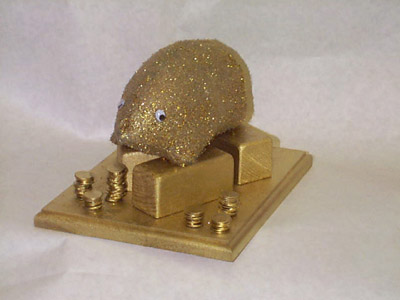Gold |
|
Gold Desiree Puruganan Gold is a metallic element and its chemical symbol is Au. It was one of the world’s first known metals, and having possession of this attractive bright yellow metal has always been a symbol of wealth for thousands of years. The ancient Egyptians knew how to hammer gold into a leaf (thin sheet) so thin that it took 367,000 leaves to make a pile 1 inch high. During the Middle Ages, a whole science called alchemy grew up around the effort to make gold by artificial means. Gold is very popular and attractive in many cultures around the world. Gold has always been valuable throughout the ages because it is scarce. The metal is prized because of its physical properties: beauty, softness, resistance to chemicals, and density. Gold has a beautiful yellow color and a soft metallic glow. Its softness makes it very easy to shape into many things and work with. Scientists describe gold as ductile because it can be drawn out into fire wire, and scientists also call it malleable because it can be hammered into very thin sheets. Basically, it can be shaped into any shape you want. After it is shaped, its resistance to rust and other chemical changes from the air keeps it from tarnishing. When gold is made into a hard object, for example, like a piece of jewelry, it must be combined with some other metal. This mixture is called an alloy. Gold alloys are measured by karats, and a karat is equal to one twenty-fourth part. Twenty-four karat (24K) gold is pure gold, and eighteen karat (18K) gold is pure gold to 6 parts of other metal. Scientists believe that gold is deposited from gases and liquids rising from beneath the earth’s surface. These gases and liquids travel toward the surface through faults (cracks) in the crust. Gold is found in lode deposits, in placer deposits, as a minor element in porphyry copper, and in sea water. Gold is seldom found in an unalloyed, or pure, state. It is usually combined with silver in a natural alloy called an electrum. But it is usually associated with quartz, calcite, lead, tellurium, zinc, or copper, and is usually mined as a by-product of these metals. Pure gold melts at 1064.43 C, and boils at 2807 C. It is in Group I of the table of chemical elements, with an atomic weight of 196.967 and an atomic number of 79. Its density is 19.32 grams per cubic centimeter at 20 C. It can be dissolved in a mixture of hydrochloric and nitric acids, called aqua regia. It also can be dissolved in alkaline cyanide solutions, a hot solution of ferric chloride, thiosulfate solutions, mercury, or nascent (free) chlorine. The chief gold-producing countries of the world, in the order of their importance, are South Africa, Russia, China, and Canada. The richest gold field of the world is the Witwatersand, which is located in the Transvaal province of South Africa. The Pueblo Viejo mine in the Dominican Republic is the largest gold mine in the Western Hemisphere. In the United States, the Mother Lode fields of California for many years supplied the most gold. South Dakota leads the states in gold production. Other leading states in gold production are Arizona, Nevada, New Mexico, and Utah. Ontario, Canada, ranks as North America’s greatest source of gold. Most of the gold is found in large, deep, quartz-gold veins. British Columbia, the Northwest Territories, Quebec, and the Yukon Territory also are important gold-producing areas in Canada. Western Australia has been famous for lode gold for many years. During the early 1900’s, the Philippines also became an important product of gold. There are many uses for gold. Nations use gold as a form of international money. All countries accept gold in payment for international debts. Countries sometimes are forced to use their gold reserves to make payments when their currency in unacceptable to those from those who buy. Gold is also used for jewelry, most commonly alloyed with other metals like copper and silver. White gold, made from gold alloyed with other metals such a platinum, palladium, or silver, is a common setting for precious stones in rings. |
